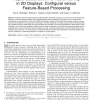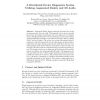856 search results - page 62 / 172 » 3D Face Recognition Using Stereoscopic Vision |
130
click to vote
TOH
2010
14 years 10 months ago
2010
—Participants learned through feedback to haptically classify the identity of upright versus inverted versus scrambled faces depicted in simple 2D raised-line displays. We invest...
107
click to vote
BIOSIG
2007
15 years 1 months ago
2007
: 2D Face images are traditionally used in civil governmental applications. An extension from 2D to 3D images will lead to several advantages when setting up automated authenticati...
111
click to vote
CIARP
2009
Springer
15 years 6 months ago
2009
Springer
This paper gives an overview of works done in our group on 3D and appearance modeling of objects, from images. The backbone of our approach is to use what we consider as the princi...
127
click to vote
CG
1999
Springer
14 years 11 months ago
1999
Springer
Augmented Reality brings technology developed for virtual environments into the real world. This approach can be used to provide instructions for routine maintenance and error diag...
107
click to vote
ICMCS
2005
IEEE
15 years 5 months ago
2005
IEEE
The main achievement of this work is the development of a new face recognition approach called Partial Principal Component Analysis (P2 CA), which exploits the novel concept of us...


